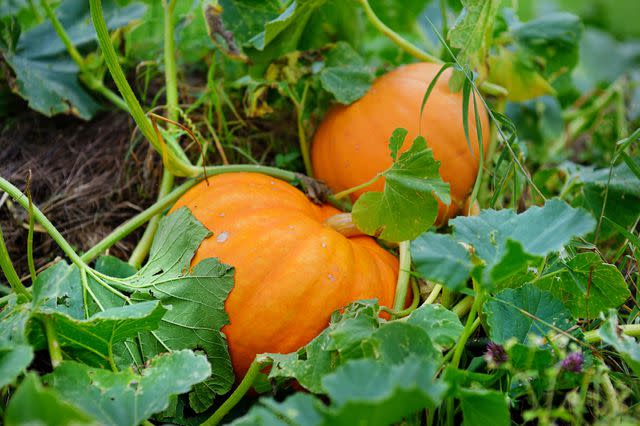This Is How Many Pumpkins You Can Grow on One Plant
How many pumpkins you can get from a single plant depends on a multitude of factors. Some of it depends on a gardener's level of experience, but you don't have control over everything. The pumpkin variety, location, and other environmental factors all play a role in a pumpkin vine's output.
Want to boost your pumpkin crop? Follow these guidelines for getting the most out of your pumpkin plants.
How Many Pumpkins Can a Single Plant Produce?
If you plant a single pumpkin seed in your backyard expecting a pumpkin patch to appear, prepare to be disappointed. From a standard pumpkin vine, you can expect an average of two to five pumpkins. But that all depends on the size of the pumpkins. Some smaller varieties can produce as many as 12 per plant, whereas growers of giant pumpkins limit growth to one pumpkin per vine.
There are other environmental factors involved as well.

What Determines the Number of Pumpkins Per Plant?
Pumpkin Variety
The biggest influence on a pumpkin plant's yield is its variety type. There are more than 250 varieties of pumpkins that vary in shape, size, and color. When you think of a pumpkin, you probably imagine a perfectly round orange shape fit for turning into a Jack-O'-lantern for Halloween. But there are plenty of other pumpkin varieties that come in different shades of white or green.
In general, the larger the pumpkin variety, the fewer pumpkins will grow on the vine. That's because it takes a lot of resources to grow a bigger fruit.
With larger pumpkin varieties such as Jackpot, Autumn Gold, Jumpin' Jack, and Gladiator, you can expect two to five pumpkins that weigh between 10 and 25 pounds per plant. For mini pumpkins that weigh less than two pounds—varieties such as Baby Boo, Bumpkin, Munchkin, and Hooligan—the yield per plant could be as much as 10 to 12 pumpkins.
Weather
As with all plants, sunlight and water are key to a pumpkin plant's success. Pumpkins are thirsty plants and need a minimum of one inch of water per week. They require more water during times of heat and drought. Too much rain, however, can cause the plants to develop root rot.
To grow optimally, pumpkin plants require at least six to nine hours of full sun per day. So when choosing a location to plant your pumpkin seeds or seedlings, choose a sunny spot.
Space
Pumpkins grow on vines, which need a lot of space to grow and climb. If you want to maximize the number of pumpkins you get from a plant, make sure you don't crowd them while planting. Plant the seeds in mounds with a two- to six-foot gap between each.
If planted too closely, the pumpkin plants will compete for water and nutrients. The flowers and young fruits may drop off or shrivel up if the plants don't have enough nourishment.
Soil Quality
Pumpkins will grow in a variety of soil types, but they thrive in sandy or loamy soils with good drainage and moisture retention. They do not respond well to soggy, heavy soils.
Because pumpkins are such heavy feeders, it can be helpful to mix compost into the soil when prepping for planting. This will help provide the vines with a steady flow of nutrients throughout the season.
Pollination Success
Pumpkins, which are a type of winter squash, are technically the fruit of a flowering plant. Similar to zucchini, butternut, and other squashes, pumpkin vines produce both male and female flowers. Pollen from the male flowers pollinates the female flowers—either by hand or via pollinators such as bees and wasps—which then triggers the pumpkins to grow.
If anything goes wrong during the pollination process and a flower isn't successfully pollinated, that could reduce the number of healthy pumpkins the plant is able to produce.
Pests or Diseases
Some pumpkin varieties are prone to a pest known as the squash vine borer, which attacks squash, zucchini, pumpkins, and various types of gourds. If the borer burrows into your pumpkin vine, it can prevent the plant from taking up any water or nutrients.
If your pumpkin plant is infested with squash vine borers or any other pest or disease, that can significantly reduce its output.
How to Maximize Your Pumpkin Yield
To maximize your pumpkin harvest, be sure your plant has the right nutrients from the start. Add compost and fertilizer to get higher yields. You can also increase the yield on a vine by removing all female flowers during the first three weeks it produces them. This allows the vine to grow long and healthy before it begins directing its energy and nutrients to fruit production.
To ensure the flowers get pollinated, plant pollinator-friendly plants like asters and zinnias. You can also pollinate the squash flowers by hand.
Routinely monitor your pumpkin plant for signs of pests or disease. Preventing these issues, and catching them early if they do occur, is the best way to get the maximum number of pumpkins from your plant.
Read Next: How to Grow Giant Pumpkins That Are Worthy of Prizes
Read the original article on The Spruce.

